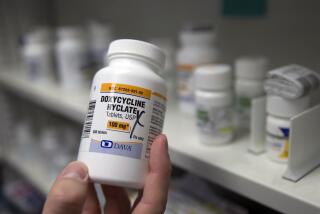STDs Often Undetected, Causing Infertility
- Share via
Doctor: “We think we have discovered why you are unable to get pregnant. Your Fallopian tubes are severely scarred--most likely the result of a sexually transmitted disease like gonorrhea or chlamydia.”
Patient: “But, doctor, how could that be? I’ve never had a sexually transmitted disease.”
Farfetched? Hardly. Medical experts estimate that nearly 100,000 women become infertile each year as a result of sexually transmitted diseases, or STDs, that, in many cases, cause no symptoms. In those cases, the victims of these diseases have no way of knowing they’ve been infected until complications, including infertility, show up years later.
For decades, public health warnings have focused on the obvious signs and symptoms of STDs: blisters, warts and open sores in the genital region, vaginal and penile discharge, burning during urination, pelvic pain and fever.
Even in medical school, lectures about sexually transmitted diseases were always accompanied by a graphic slide show. But the “D” in STD is often silent. Sexually transmitted diseases frequently don’t cause any symptoms.
Chlamydia, a common bacterial infection, is a good example: Symptoms are absent in about three of four infected women and half of infected men. And chlamydia is by no means unique. The Centers for Disease Control and Prevention estimate that millions of U.S. men and women with gonorrhea are unaware that they have it; millions more have been unknowingly infected with the virus that causes genital warts.
The symptoms of STDs, although very uncomfortable and unpleasant, serve an important purpose: They let you know you have been infected. Unrecognized infections can’t be treated, and untreated STDs can lead to serious complications, particularly in women.
Up to 40% of women with untreated chlamydia or gonorrhea develop pelvic inflammatory disease, or PID, a severe infection of the upper genital tract that can scar the Fallopian tubes, blocking the passage for sperm and eggs. Complete blockage of the tubes can result in infertility; partial blockage can result in a life-threatening tubal (or ectopic) pregnancy. (Of women with PID, 20% will become infertile, and 9% will have an ectopic pregnancy.)
Women who have suffered PID also frequently complain of pelvic pain and painful intercourse that may persist for years after the infection is treated.
Because so many women with STDs never have symptoms, the public health message about these diseases has changed:
Don’t take chances with STDs, because you can’t count on warning symptoms or signs to let you know you’ve been infected.
* If you don’t want to suffer the complications of an STD, don’t expose yourself to the risk of infection.
* Although nothing short of abstinence can guarantee that you won’t be infected, adopting healthy sexual behaviors can reduce the risk of sexually transmitted diseases.
Studies show that limiting the number of sexual partners and avoiding sex with partners who are at high risk of having an STD themselves will significantly lower your risk of exposure.
Barrier methods of contraception will also reduce your chance of exposure and infection and should be used even if contraception is not needed.
Latex condoms are probably the best choice, but the use of vaginal spermicide and a diaphragm also appears to decrease a woman’s risk of contracting a sexually transmitted infection. (Latex condoms, by the way, are thought to be more effective than their natural-membrane counterparts.) Using a combination of barrier methods may provide even more protection.
When an infection occurs, early diagnosis and treatment is essential. If you experience pain when urinating or abnormal discharge from the penis or vagina, you should immediately get tested for chlamydia and gonorrhea.
Public health experts believe that some people without symptoms should also be tested, in order to detect the “silent” infections before complications occur. The U.S. Preventive Services Task Force currently recommends testing all “high-risk women” for gonorrhea and chlamydia (because men are more frequently symptomatic, testing is not recommended for symptom-free men).
The government says a woman is at high risk of chlamydia if she is: younger than 25 and sexually active; has had a prior sexually transmitted disease; has a new or multiple sex partners; and, if unmarried and sexually active, does not consistently use barrier contraceptives.
Women are at high risk of gonorrhea, and should be tested, if they have a history of repeated episodes of gonorrhea, or if they are younger than 25 and have had two or more sex partners in the last year who are considered to be at high risk of gonorrhea.
If you are diagnosed with an STD, prompt and appropriate treatment is essential to prevent dangerous complications. STDs such as gonorrhea and chlamydia, which are caused by bacteria, can be quickly and effectively treated with antibiotics.
It is important, however, that medications be taken exactly as prescribed. If taken incorrectly, these medications may be ineffective and can actually make the infection more difficult to treat later.
To prevent reinfection, you should abstain from sex during treatment and should not resume sexual activity until your partner, or partners, have been treated as well.
*
Dr. Jonathan Fielding is the director of public health and the health officer for the Los Angeles County Department of Health Services. Dr. Valerie Ulene is a board-certified specialist in preventive medicine practicing in Los Angeles. Send questions to ourhealth@dhs.co.la.ca.us. Their column appears the second and fourth Mondays of the month.






